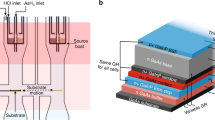Abstract
We report on an AlGaAs/GaAs solar cell with a significantly increased high-energy response that was produced via a modified liquid phase epitaxy (LPE) technique. This technique uses a one-step process in which the solid–liquid equilibrium Al-Ga-As:Zn melt in contact with an n-type vendor GaAs substrate simultaneously getters impurities in the substrate that shorten minority carrier lifetimes, diffuses Zn into the substrate to create a p–n junction, and forms a thin p-AlGaAs window layer that enables more high-energy light to be efficiently absorbed. Unlike conventional LPE, this process is performed isothermally. In our “double Al” method, the ratio of Al in the melt (“Al melt ratio”) that was used in our process was two times more than what was previously reported in the record 1977 International Business Machines (IBM) solar cell. Photoluminescence (PL) results showed our double Al sample yielded a response to 405 nm light (“blue light”), which was more than twice as intense as the response from our replicated IBM cell. The original 1977 cell had a low-intensity spectral response to photon wavelengths under 443 nm (Woodall and Hovel in Sol Energy Mater Sol Cells 29:176, 1990). Secondary ion mass spectrometry results confirmed the increased blue light response was due to a large reduction in AlGaAs window layer thickness. These results proved increasing the Al melt ratio broadens the spectrum of light that can be transmitted through the window layer into the active GaAs region for absorption, increasing the overall solar cell efficiency. Our enhanced double Al method can pave the way for large-scale manufacturing of low-cost, high-efficiency solar cells.
Similar content being viewed by others
References
J.M. Woodall and H.J. Hovel, Sol. Energy Mater. Sol. Cells 29, 176 (1990).
J.M. Woodall and H.J. Hovel, Appl. Phys. Lett. 21, 379 (1972).
M.B. Small, R. Ghez, R.M. Potemski, and J.M. Woodall, Appl. Phys. Lett. 35, 209 (1979).
F. Dimroth, A.W. Bett, and W. Wettling, J. Cryst. Growth 179, 41 (1997).
J.M. Woodall and H.J. Hovel, J. Cryst. Growth 39, 108 (1977).
A. Polman, M. Knight, E.C. Garnett, B. Ehrler, and W.C. Sinke, Science 352, 1 (2016).
Acknowledgements
The authors would like to thank the members of Woodall Research Group, especially Joel C. Schmierer for editing and Dr. Zhaoquan Zeng for his lab assistance. The authors also thank Araseli Saldivar for editing.
Author information
Authors and Affiliations
Corresponding author
Rights and permissions
About this article
Cite this article
Noorzad, C.D., Zhao, X., Harotoonian, V. et al. Improved High-Energy Response of AlGaAs/GaAs Solar Cells Using a Low-Cost Technology. J. Electron. Mater. 45, 6317–6322 (2016). https://doi.org/10.1007/s11664-016-5015-2
Received:
Accepted:
Published:
Issue Date:
DOI: https://doi.org/10.1007/s11664-016-5015-2




